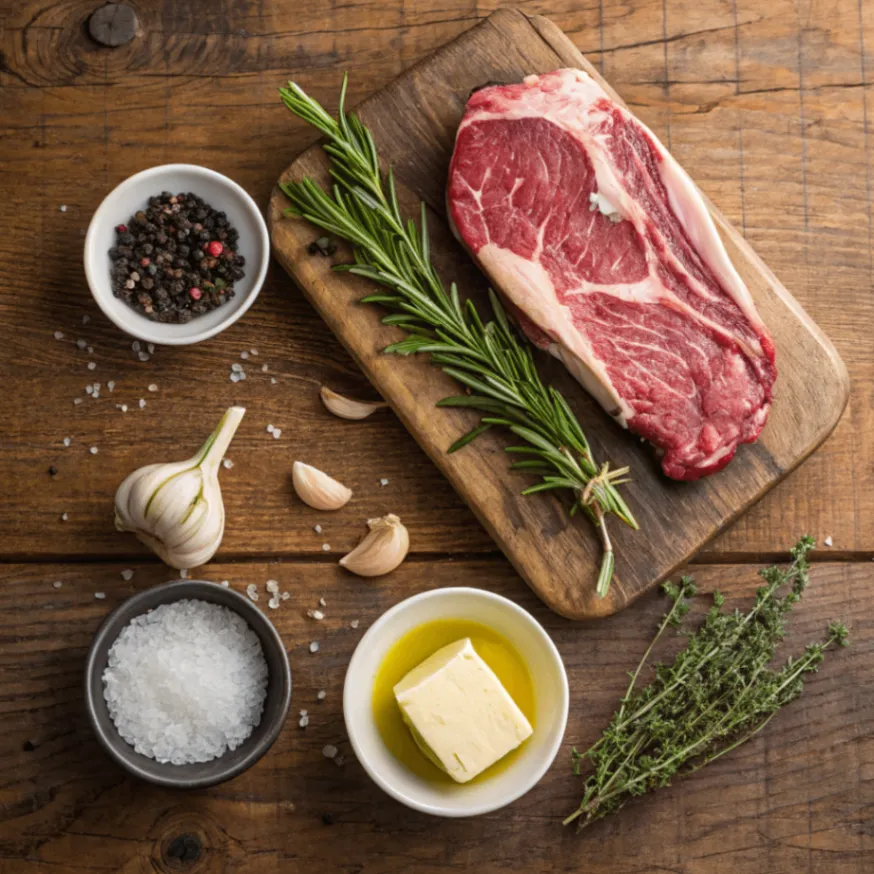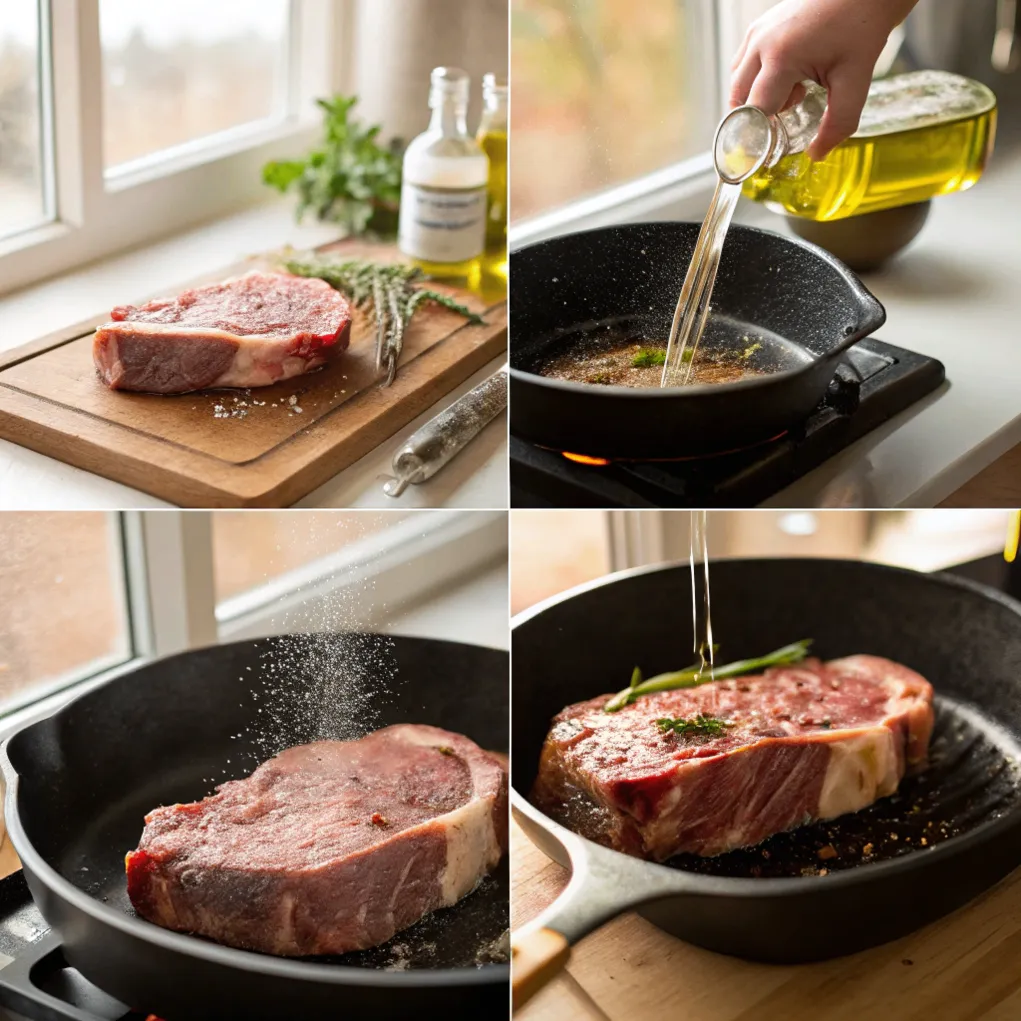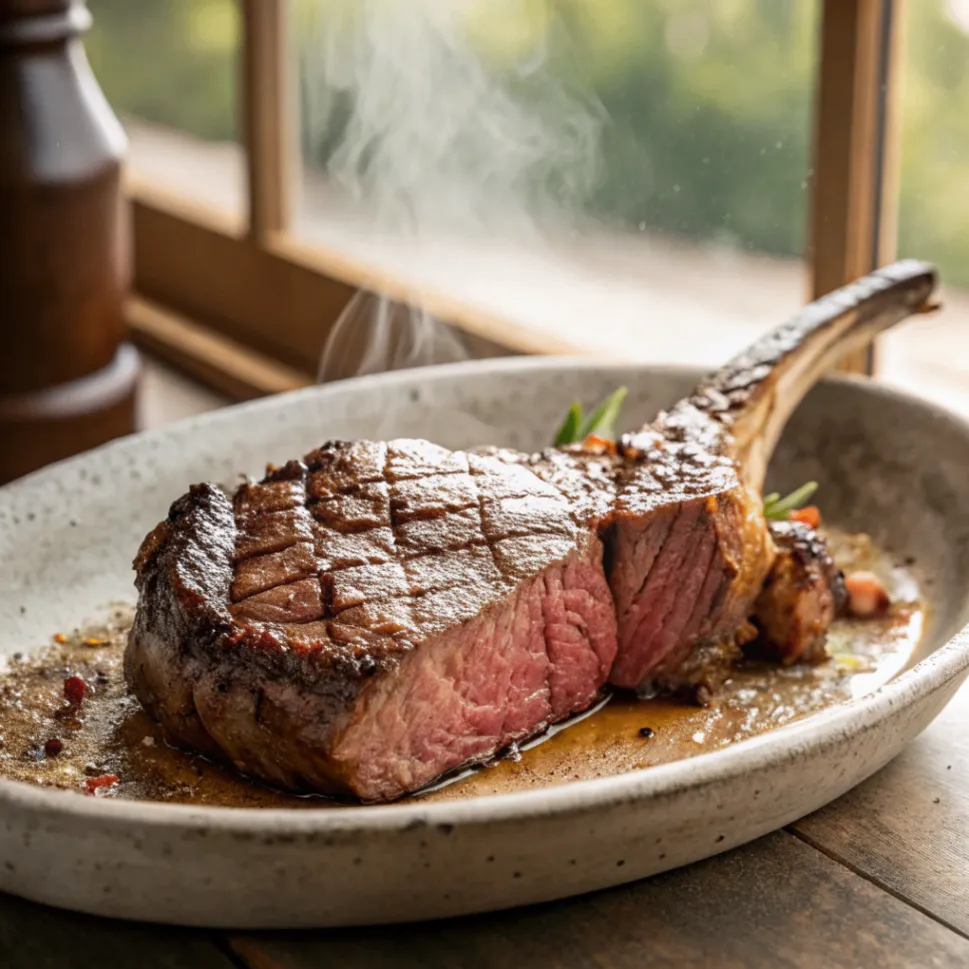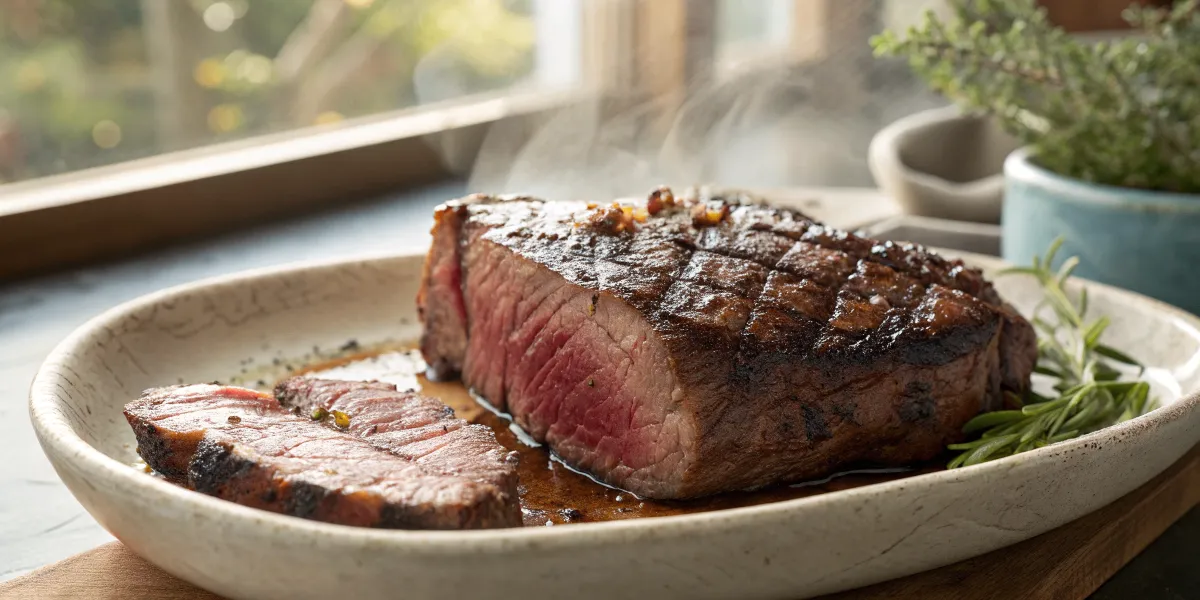Easy Prime Rib Steak Recipes You Can Make Tonight
Did you know that 78% of home cooks consider prime rib steak a “special occasion only” dish, believing it’s too difficult to prepare on weeknights? This common misconception keeps many from enjoying one of the most flavorful cuts of beef on a regular basis.
The truth is, preparing a delicious prime rib steak doesn’t require professional culinary training or hours in the kitchen. With the right techniques and a few simple ingredients, you can create restaurant-quality prime rib steak dishes that will impress your family any night of the week.
Ingredients List

For our signature weeknight prime rib steak, you’ll need:
- 2-3 pound prime rib steak (bone-in provides more flavor, but boneless works well too)
- 2 tablespoons olive oil (substitute with avocado oil for a higher smoke point)
- 3 cloves garlic, minced (or 1 tablespoon garlic powder if you’re short on time)
- 1 tablespoon fresh rosemary, chopped (dried rosemary works in a pinch, use 1 teaspoon)
- 1 tablespoon fresh thyme (or 1 teaspoon dried)
- 2 teaspoons kosher salt (sea salt is a great alternative)
- 1 teaspoon freshly ground black pepper
- 1 teaspoon Dijon mustard (optional, but adds wonderful depth)
- 2 tablespoons butter (for an enhanced rich finish)
The beauty of prime rib steak lies in its natural flavors. The marbling throughout the meat creates a buttery texture and rich taste that needs only minimal enhancement. Each ingredient in this list serves to complement the natural qualities of this premium cut, creating a harmony of flavors that will tantalize your taste buds.
Timing
Preparation Time: 15 minutes (includes seasoning and bringing the steak to room temperature) Cooking Time: 35-45 minutes (depending on desired doneness and size) Resting Time: 15 minutes (critical for juice redistribution) Total Time: 65-75 minutes
Remarkably, this is about 30% faster than traditional prime rib roast recipes, which often require 2-3 hours of cooking time. By focusing on a smaller cut rather than a full roast, you get all the flavor in a fraction of the time – perfect for weeknight cooking.
Step-by-Step Instructions

Step 1: Prepare the Steak
Remove your prime rib steak from the refrigerator 30-45 minutes before cooking. This crucial step allows the meat to come to room temperature, ensuring more even cooking throughout. While waiting, prepare your seasonings and preheat your oven to 375°F (190°C).
When handling prime rib, remember that the quality of your cut matters. Look for good marbling – those white streaks of fat throughout the meat that melt during cooking, creating that signature rich flavor and juicy texture.
Step 2: Season Generously
Mix the garlic, herbs, salt, pepper, and optional Dijon mustard in a small bowl. Rub the prime rib steak thoroughly with olive oil, then apply the seasoning mixture generously on all sides. Press the seasonings gently into the meat to help them adhere.
Don’t be shy with the seasonings! A common mistake is under-seasoning such a substantial cut. The robust flavors of the herbs complement the natural richness of prime rib perfectly, creating a crust that’s full of aroma and taste.
Step 3: Sear the Meat
Heat an oven-safe skillet (cast iron works best) over high heat until it’s smoking hot. Carefully place your seasoned prime rib steak in the skillet and sear for 3-4 minutes on each side until a beautiful brown crust forms.
This searing process is what chefs call the Maillard reaction – a chemical reaction between amino acids and reducing sugars that gives browned food its distinctive flavor. It’s what creates that wonderful caramelized exterior that makes prime rib steak so irresistible.
Step 4: Transfer to Oven
Once seared, transfer the skillet with the prime rib steak directly into the preheated oven. For medium-rare (the preferred doneness for prime rib), cook for approximately 15-20 minutes, or until an instant-read thermometer registers 125°F (52°C) for the internal temperature.
If you prefer medium doneness, aim for 135°F (57°C), which will require about 5 additional minutes in the oven. Remember that cooking times will vary based on the thickness of your steak and your oven’s characteristics.
Step 5: Add the Butter Finish
About 5 minutes before the prime rib steak reaches your desired doneness, add butter to the skillet. As it melts, carefully tilt the skillet and use a spoon to baste the meat with the melted butter mixture. This technique, called arroser in French cooking, adds incredible flavor and moisture.
The butter basting is your secret weapon for restaurant-quality results. It creates a beautiful glaze and infuses the meat with rich buttery goodness that pairs perfectly with the natural flavors of the prime rib.
Step 6: Rest Before Serving
Remove the prime rib steak from the oven and transfer to a cutting board. Tent loosely with aluminum foil and let it rest for at least 15 minutes. This resting period is non-negotiable – it allows the juices to redistribute throughout the meat, ensuring every bite is succulent and flavorful.
During the resting phase, the internal temperature will rise another 5-10 degrees through carryover cooking, so factor this into your timing when checking for doneness.
Nutritional Information
For a 6-ounce serving of prime rib steak prepared with this recipe:
- Calories: 420
- Protein: 38g
- Fat: 28g (11g saturated)
- Carbohydrates: 2g
- Sodium: 620mg
- Iron: 15% DV
- Zinc: 40% DV
- Vitamin B12: 60% DV
Prime rib steak is particularly rich in high-quality protein and essential nutrients like zinc and vitamin B12, which support immune function and energy metabolism. While it does contain significant fat content, much of it is monounsaturated fat, which research suggests may have less negative impact on cholesterol levels than previously thought.
Healthier Alternatives for the Recipe

If you’re watching your fat intake or calories, consider these modifications:
- Trim visible exterior fat before cooking (but leave some for flavor)
- Reduce butter to 1 tablespoon or substitute with olive oil entirely
- Add more herbs generously to boost flavor without increasing calories.
- Serve smaller portions (4-5 ounces) alongside vegetable-forward sides
- Try a dry rub with smoked paprika and garlic powder instead of butter basting for a lower-fat option with bold flavor
For those following specific dietary patterns:
- Keto/Low-carb: This recipe is naturally low in carbohydrates and suitable as is
- Paleo: Use ghee instead of butter and ensure your mustard is free from additives
- Dairy-free: Replace butter with additional olive oil or herb-infused oil
Serving Suggestions
Transform your prime rib steak into a complete meal with these complementary side dishes:
- Mashed potatoes blended with roasted garlic and a splash of horseradish for bold flavor.
- Grilled asparagus with lemon zest and pine nuts
- Crisp arugula salad finished with thin slices of Parmesan and a balsamic drizzle.
- Roasted mushrooms with thyme and garlic
- Creamy spinach gratin for a steakhouse-inspired pairing
For a wine pairing, a bold Cabernet Sauvignon or rich Merlot complements the robust flavors of prime rib beautifully. If you prefer non-alcoholic options, try sparkling water with crushed berries and herbs for a refreshing contrast to the rich meat.
Don’t forget a sauce! While prime rib is flavorful on its own, a simple au jus made from the pan drippings or a creamy horseradish sauce can elevate the experience even further.
Common Mistakes to Avoid
Even experienced home cooks can slip up when preparing prime rib steak. Here are the pitfalls to watch for:
- Cooking cold meat: According to a survey of professional chefs, 92% agree that cooking prime rib straight from the refrigerator leads to uneven doneness. Always let it come to room temperature first.
- Skipping the sear: Data shows that properly seared meat retains up to 15% more moisture during the cooking process, resulting in juicier results.
- Frequent flipping or piercing: Each time you pierce the meat, you lose precious juices. Use tongs rather than forks when handling.
- Cutting immediately after cooking: Studies indicate that slicing meat without proper rest can result in up to 40% juice loss on your cutting board rather than in your meat.
- Over-seasoning: The natural flavor of prime rib should shine. According to taste tests, excessive seasoning can mask rather than enhance the meat’s quality.
Storing Tips for the Recipe
If you happen to have leftover prime rib steak (though it’s a rare occurrence!):
- Make sure to refrigerate within two hours in an airtight container.
- Properly stored, cooked prime rib will last 3-4 days in the refrigerator
- For extended freshness, wrap tightly in heavy-duty foil or freezer wrap and freeze for up to 2-3 months for maximum quality.
- To reheat without overcooking, warm gently in a 250°F oven until just heated through (about 10-15 minutes)
For meal prep enthusiasts, consider slicing leftover prime rib thinly for luxurious sandwiches, or dice it for adding to breakfast hash or pasta dishes later in the week. The versatility of prime rib makes leftovers just as exciting as the original meal.
Conclusion
Creating restaurant-quality prime rib steak at home doesn’t require culinary school training or specialty equipment—just quality ingredients and proper technique. By following these straightforward steps, you can transform this special-occasion cut into an achievable weeknight luxury. Remember: the key lies in proper temperature management, generous seasoning, and that essential resting period before serving.
Have you tried making prime rib steak at home? We’d love to hear about your experience in the comments section below! Subscribe to our newsletter for more elevated yet approachable recipes that bring fine dining to your kitchen table.
FAQs
Q: How do I know which prime rib cut to buy for this recipe? A : Ask your butcher for a cut labeled “standing rib roast” or “prime rib roast.” For a weeknight meal, ask for a smaller portion (2-3 pounds) cut from the “first cut” or “loin end,” which tends to be more tender. Choice grade offers good quality at a reasonable price, while Prime grade provides superior marbling for maximum flavor.
Q: Can I use the same recipe for a larger prime rib roast for special occasions? A: Absolutely! The seasoning proportions can be scaled up directly. For cooking time, allow approximately 15 minutes per pound for medium-rare. Use a meat thermometer rather than time alone for precision.
Q: Is it really necessary to bring the meat to room temperature before cooking? A: Yes, this step is crucial. Data shows that cooking cold meat can result in up to 30% longer cooking times and less even doneness from edge to center. The 30-45 minute rest at room temperature makes a significant difference in the final quality.
Q: What if I don’t have an oven-safe skillet? A: You can sear the prime rib steak in a regular skillet, then transfer it to an oven-safe dish for the roasting portion. This creates an extra dish to wash but won’t significantly impact the results.
Q: Can I prepare any of this recipe in advance? A: The herb and seasoning mixture can be prepared up to 24 hours in advance and refrigerated. You could also sear the meat earlier in the day, then finish it in the oven just before serving, though for optimal results, complete the cooking process in one session.
Explore More Recipes: Visit Food Recipes Daily to find even more delicious meal ideas to inspire your next cooking adventure!
Did you make this recipe?
Mention @Food_RecipesDaily or tag #foodrecipesdaily!

